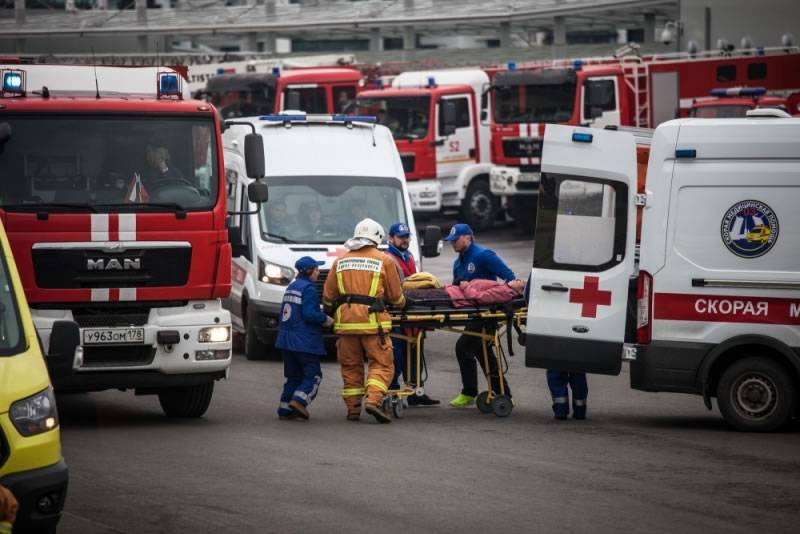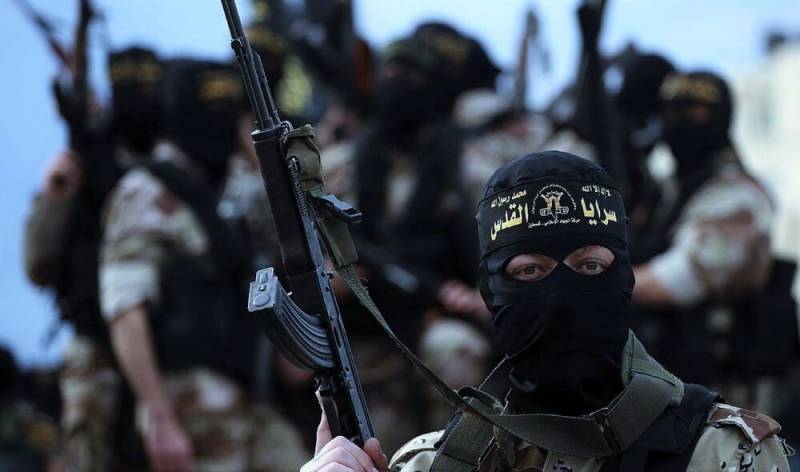Fell, didn’t do push-ups - a little about physiology and a lot about catatrauma

Who is warned is saved
In connection with the SVO in Russia and Belarus, there was a threat of terrorist attacks, many of which may not have Ukrainian roots, but simply be the result of a gang showdown, which is very convenient to attribute to nationalists, Bandera and other extremists. Among the latter, there will always be people who, for the sake of earning dividends on shocking, will take responsibility for these actions, as Salman Raduev did in his time.
Among the medical consequences of such emergencies, not the last place is occupied by catatrauma - damage to the body resulting from a fall from a height. They are observed, first of all, during terrorist attacks carried out on the upper floors of buildings, both directly as a result of a person being ejected from a height by a blast wave, and when trying to save himself in case of a fire that has arisen or in a panic during the violent actions of terrorists (for example, when taking hostages or pogrom in room).
It is far from always that the fighters of the Ministry of Emergency Situations, who are usually the first to arrive at the scene of an accident, can deal with the features of such injuries in victims before the arrival of the disaster medicine service.
To begin with, let's talk about common pseudo-medical (or paramedical, although this word has already stuck in my teeth) misconceptions about the physiology of catatrauma. The first misconception is that the lower the height and trajectory of the fall, the easier the damage. In fact, a high degree of mortality is also observed in falls from a height of one's own growth.
A person does not always have time in such a situation to group, it all depends on his reaction and physical fitness. This is especially true for injuries received in combat and street fights, when a fall on a hard surface is preceded by a loss of consciousness caused by various factors: a blow with a blunt object (albeit a well-placed knockout punch, usually to the temple, back of the head or lower jaw), a gunshot or knife wound, blast wave.
The most severe injuries in these cases are observed as a result of craniocerebral injuries from hitting the head on a hard, immovable surface. If a person is under the influence of psychoactive substances, this can only increase the risk of mortality or disability.
Regarding the last moment, there is another common misconception, which among the people sounds like “drunks are always lucky.” Those rare cases when, under the influence of surfactants, a person, when falling even from a great height, escaped with minor injuries, they do not affect the statistics in any way. Most often, this was due to an accidental landing on some kind of shock-absorbing surface, such as bushes or the roof of a car under a window.
Fell on a jeep and... didn't come back
So, in particular, a few years ago it was with a drunk junior reserve sergeant on the day of the Airborne Forces, who, when falling from the 8th floor, escaped with bruises and cracked ribs, landing flat on the roof of a neighbor's jeep. Often - with deliberate jumping on a dispute from high floors to the nearest tree in order to reduce the acceleration of free fall due to obstacles in the form of branches. An example is a jump from the 5th floor onto a birch of a cemetery worker in Apatity, Murmansk region, who was under the influence of alcoenergetics, filmed on a phone camera.

Although, of course, options are possible. Theoretically, a person under the influence of psychostimulants responds better than those under the influence of alcohol, opiates or cannabinoids. But in practice, often occurring jumps from windows under the influence of the infamous "salts" and mephedrone lead either to death or disability, most often due to the fact that a person simply does not realize what he is doing, or simply commits deliberate suicide.
The least damage occurs when a person manages to at least instinctively group and land on four limbs: modern medicine treats fractures of the arms and legs successfully, but with the spine and ruptures of internal organs it is already worse. On the other hand, when falling onto a hard, immovable surface without shock absorption along the fall path by any relatively soft objects (for example, tree branches), the survival threshold is approximately the 7th floor of a conventional “brezhnevka”, where the floor height is about three meters.
Further, even if a person is in the “correct” position when landing, the free fall acceleration is so high that the limbs will not help absorb damage to the torso and head, which most often leads to death, if not immediately, then after a few days. In general, employees of disaster medicine have an unspoken rule that if a person was taken to the hospital alive after falling from a height of more than 4-5 floors of Brezhnevka, then he has a chance to continue to live (the question is, maybe, disabled) he has.
From other catatrauma injuries when falling from a height of from the 4th to the 7th floors of residential apartment buildings, they differ in the rule “either pan or go”. That is, the percentage of disability is rather lower than the percentage of mortality. Either the person landed successfully (ideally, on four limbs, there is no need to talk about rolling, it happens when jumping from such a height only in films about parkour) and the integrity of the bones of the arms and legs is surgically restored to him, or he receives fatal brain injuries and internal organs. When falling from low heights, the percentage of disability is quite large.
Terrorist victims
Catatraumas sustained during terrorist actions are particularly severe, and not only if the victims are unprepared civilians, but also employees of law enforcement agencies who have good physical, technical and psychological training. Let's look at some of the most typical situations:
The most optimistic option. A person is trying to escape from captivity or, being a hostage, from a room seized by terrorists on a high floor of a building, while having certain combat training. He descends either along a makeshift cable (for example, from knotted sheets), or holding on to structures protruding from the wall of the building.

The escape is thought out and prepared, the person is not in a state of panic and controls his actions quite clearly. An emergency occurs, and he breaks down. If he succeeds in grouping, the degree of injury will depend on the height, it is clear that even circus acrobats do not always manage to survive when falling from under the 30-meter dome of the circus onto soft trampolines.
If not, most often in the absence of strong wind and obstacles along the trajectory (for example, air conditioners), it lands on the entire surface of the foot. The result is multiple, often fragmentary fractures of the lower extremities, impacted fractures of the femoral necks (with such falls from a great height, fragments of the femoral necks can generally be located at the level of the ribs and diaphragm), crushing of the pelvis, compression fractures of the spine and, of course, damage (at high altitude - destruction) of internal organs (to a large extent - crushed bones of the pelvis and necks of the hips), which causes high mortality and disability. These injuries during catatrauma are classified as primary. Secondary ones are observed already when a person falls from a standing position after landing on a hard, immovable surface; craniocerebral injuries have the highest lethality.
Fall as a result of the ejection of a person from the window of the room by a blast wave. Injuries in this case are very severe, with a high degree of lethality, since injuries can be received one after another.
First, a person is injured from the blast wave and fragments or the filling of an explosive device, then - when the body breaks through the window pane (with a strong explosion, it is possible to break through the double-glazed window with the body, although it is possible that he will already knock out the glass with a wave even before the victim of the terrorist attack falls out of the window) , then - when the human body falls on a solid fixed surface.
Save who can't
Often a person lands on the surface already in an unconscious state due to concussion and injuries from the explosion, almost always he falls flat, which entails injuries to the spine, internal organs, and brain. Such injuries were observed in many of the dead and injured as a result of the terrorist attack at the railway station in Volgograd in 2013. Often, such victims are mistakenly taken to the morgue without looking, but then it turns out that they are still alive.
A jump from a window in an unconscious attempt at self-rescue during a fire that started as a result of a terrorist attack in a state of poisoning by combustion products. According to the consequences - no better than the previous paragraph. Even if a person did not suffer from a blast wave, especially in the case of administrative buildings, due to the burning of synthetic materials for finishing the room, poisoning of the body and clouding of consciousness often occur within a few seconds, into which a person inhales smoke.
Instinctively, he looks for a source of air, and this source in most cases turns out to be a window. As a rule, as a result of panic and a semi-conscious state as a result of poisoning, which can also be aggravated by shell shock, he does not try to find a place where he can stay on the window ledge for some time, waiting for rescue, but immediately "on the machine" jumps there, where there is something to breathe.
The result is disastrous with such self-rescue, even from relatively low floors, since the victim usually does not control where he will land and in what position. Often exhausted from poisoning by combustion products, people simply roll over the windowsill and cornice and fall in any position, even upside down, often changing the position of the body along the trajectory of the fall. Mortality is extremely high, aggravated by the combination of catatrauma with general poisoning of the body by combustion products and severe lung damage, burns of the respiratory tract.
An easier option is found in firefighters blocked by fire in a room, whose self-contained breathing apparatus runs out of breathing mixture - in this case, at least there is no poisoning and lung damage (although when using rebreathers, YES of a closed circuit, this can be, as a more exotic variant - a sudden hypertensive crisis during prolonged work).
The fall from the cornice of a victim of a terrorist attack, who was waiting there for rescue when a fire broke out and who did not receive shell shock and poisoning by combustion products during the terrorist attack. The consequences are usually easier than with the previous option, although they can be aggravated by burns of a large surface of the body when the victim is near a source of open fire for a long time.
In this case, the victim has time to think about where it is better to hide, what structures are nearby, where you can sit out until they remove him with a ladder or substitute a cube of life. And the eyewitnesses below also have time to either stretch the tarpaulin or throw something soft under the window - tires, cardboard boxes, garbage from nearby bins.
Attempt to flee in panic during hostage-taking or pogrom. It is more common for women who are afraid of becoming victims of sexual violence and related sadistic bullying. Given that the victims are in severe panic, with little control over their actions, serious injuries can be observed even when jumping from low floors.
In particular, the secretary, who jumped from the first floor of the Moldovan parliament building during the pogrom committed by the unionists (although the foundation there is high, the height was almost equivalent to the second floor of an apartment building), received quite serious bruises and spent several days in the hospital. According to her testimony, this happened when the carpets in the corridor were already set on fire on the first floor, and the thugs began to break down the door to her office. But there are versions that she either escaped from the fire, or jumped out when shouts were heard from the crowd: “There is a bomb in parliament.”
Cheap but angry
Employees of the Ministry of Emergency Situations and anti-terrorist units should take into account the extreme variety of medical consequences of a fall from a height, especially if they are aggravated by poisoning by combustion products, shell shock, burns, wounds received directly from fragments, the filling of an explosive device, and other objects accelerated by an explosive wave.
Often, even professional employees of the disaster medicine service cannot immediately understand the severity of injuries and their number. In this regard, the actions of law enforcement agencies in relation to such victims should be extremely careful.
There is an elementary rule stating that during the liquidation of the consequences of terrorist attacks, victims, primarily from a fall from a height, are allowed to be moved only if it is necessary to isolate them from a source of danger, for example, if there is an open fire in the immediate vicinity, a clear danger of repeated explosions, or if there is a the immediate vicinity of terrorists who have not yet been neutralized. All other movements of victims can only be carried out by the disaster medicine service.
Preventive measures against such consequences can be expressed, first of all, in equipping administrative and other non-residential buildings with self-rescue systems from a height, which most often become targets of terrorist attacks. These systems usually represent a kerchief moving with deceleration of free fall acceleration along the cable, where a person is fixed. The cable is attached to an anchor bolt near the window.
Such systems are cheap, but they also have disadvantages: usually a short cable length and an unregulated descent speed, which, as a rule, is higher than, for example, when jumping with a parachute. With a poor physical condition of a person, this can lead to negative consequences. It also seems appropriate that security services for non-residential premises, especially those that may be of particular interest to terrorists, acquire jumping rescue devices, colloquially known as the "cube of life."
Information